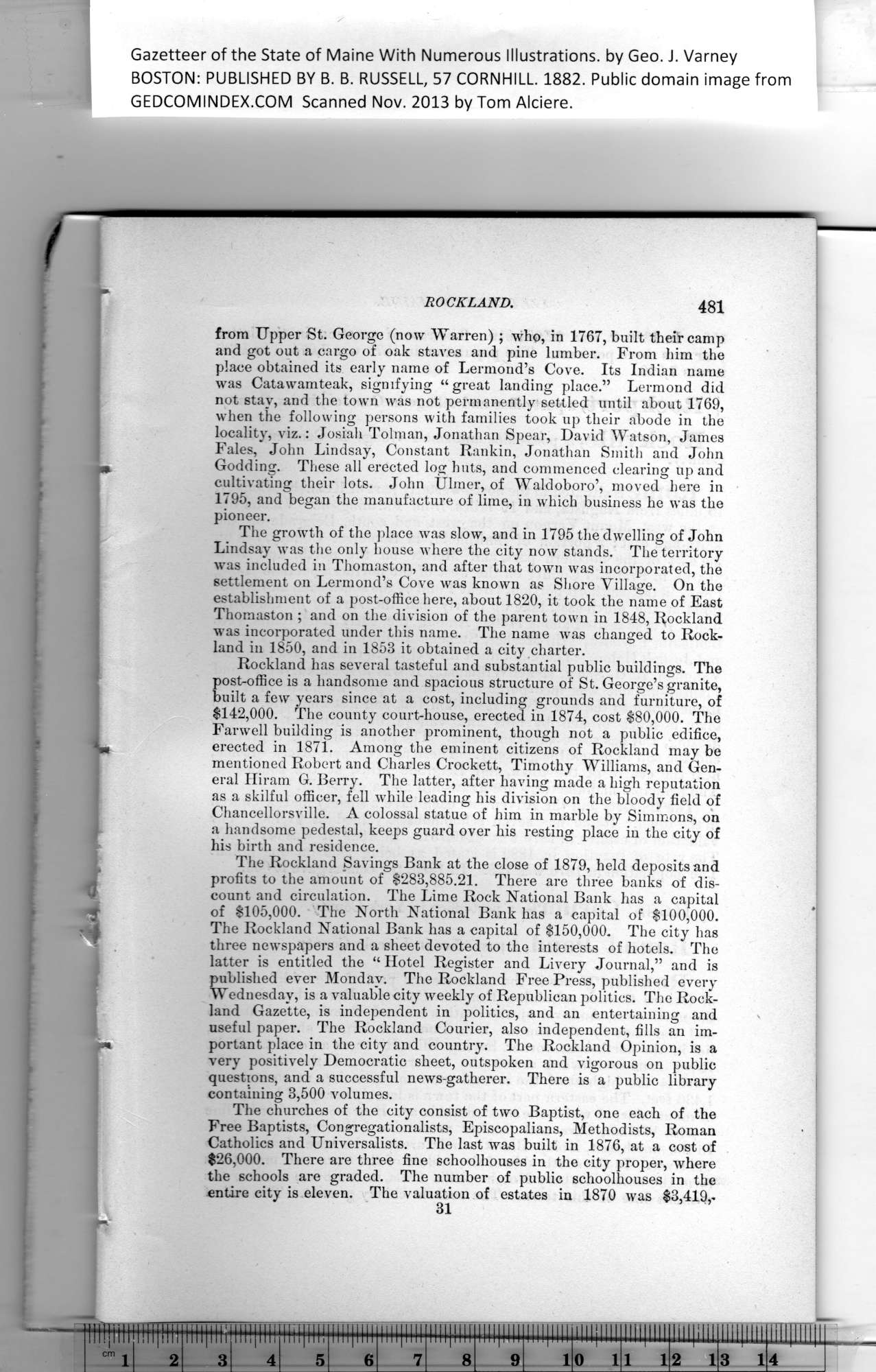|
Gazetteer of the State of Maine With Numerous Illustrations, by Geo. J. Varney
BOSTON: PUBLISHED BY B. B. RUSSELL, 57 CORNHILL. 1882. Public domain image from
ROCKLAND.
from Upper St. George (now Warren) ; who, in 1767, built their camp
and got out a cargo of oak staves and pine lumber. From him the
place obtained its early name of Lermond’s Cove. Its Indian name
was Catawamteak, signifying “great landing place.” Lermond did
not stay, and the town was not permanently settled until about 1769,
when the following persons with families took up their abode in the
locality, viz.: Josiah Tolman, Jonathan Spear, David Watson, James
Fales, John Lindsay, Constant Rankin, Jonathan Smith and John
Godding. These all erected log huts, and commenced clearing up and
cultivating their lots. John Ulmer, of Waldoboro’, moved here in
1795, and began the manufacture of lime, in which business he was the
pioneer.
The growth of the place was slow, and in 1795 the dwelling of John
Lindsay was the only house where the city now stands. The territory
was included in Thomaston, and after that town was incorporated, the
settlement on Lermond’s Cove was known as Shore Village. On the
establishment of a post-office here, about 1820, it took the name of East
Thomaston ; and on the division of the parent town in 1848, Rockland
was incorporated under this name. The name was changed to Rock-
land in 1850, and in 1853 it obtained a city charter.
Rockland has several tasteful and substantial public buildings. The
post-office is a handsome and spacious structure of St. George’s granite,
built a few years since at a cost, including grounds and furniture, of
$142,000. The county court-house, erected in 1874, cost $80,000. The
Farwell building is another prominent, though not a public edifice,
erected in 1871. Among the eminent citizens of Rockland may be
mentioned Robert and Charles Crockett, Timothy Williams, and Gen-
eral Hiram G. Berry. The latter, after having made a high reputation
as a skilful officer, fell while leading his division on the bloody field of
Chancellorsville. A colossal statue of him in marble by Simmons, oh
a handsome pedestal, keeps guard over his resting place in the city of
his birth and residence.
The Rockland Savings Bank at the close of 1879, held deposits and
profits to the amount of $283,885.21. There are three banks of dis-
count and circulation. The Lime Rock National Bank has a capital
of $105,000. The North National Bank has a capital of $100,000.
The Rockland National Bank has a capital of $150,000. The city has
three newspapers and a sheet devoted to the interests of hotels. The
latter is entitled the “Hotel Register and Livery Journal,” and is
published ever Monday. The Rockland Free Press, published every
Wednesday, is a valuable city weekly of Republican politics. The Rock-
land Gazette, is independent in politics, and an entertaining and
useful paper. The Rockland Courier, also independent, fills an im-
portant place in the city and country. The Rockland Opinion, is a
very positively Democratic sheet, outspoken and vigorous on public
questions, and a successful news-gatherer. There is a public library
containing 3,500 volumes.
The churches of the city consist of two Baptist, one each of the
Free Baptists, Congregationalists, Episcopalians, Methodists, Roman
Catholics and Universalists. The last was built in 1876, at a cost of
$26,000. There are three fine schoolhouses in the city proper, where
the schools are graded. The number of public schoolhouses in the
entire city is eleven. The valuation of estates in 1870 was $3,419,-
31
PREVIOUS PAGE ... NEXT PAGE
This page was written in HTML using a program written in Python 3.2
|
